TALKING ABOUT ARCHIVES Vol.21
The band T-shirts that all fashion brands have learned to love, as told by LABORATORY/BERBERJIN mister Matoba.

Wearing a band T-shirt is like showing a business card, showing the world what kind of music you enjoy. There’s of course a cultural element to it, but these T-shirts have also grown to have value as a fashion item before anyone noticed it. One of the reasons for this is that many popular brands have decided to use them as a base for their own new designs. That’s why this time, we will look into some of the band T-shirts that have been loved by many fashion brands in the past, and by doing that explore this specific field of fashion. Our guest is mister Ryohei Matoba, working for LABORATORY/BERBERJIN® and an expert at vintage rock T-shirts.
As a general thought, band T-shirts feel like fashion while at the same time being contemporary art as well.

--- If you go back into the history of band T-shirts, how far back do they actually go?
“I think the hippie culture, which was at its biggest in America in the sixties, is the beginning of it all. Often it’s said that the T-shirts which were sold as merchandise at the venue where the Grateful Dead played were the very first.”
--- I see!
“A while later, punk culture also grew to be its own field in Great Britain, which also played a big role. One of the biggest elements here was the existence of Vivienne Westwood and Malcom McLaren. They opened their store, SEX, on King’s Road 430, London, which sped up the movement by a lot. Before they opened their store there, there was another clothes store located in the same place called Paradise Garage. The T-shirts with graphic prints being sold there also had a huge influence on the kind of designs that were used for rock T-shirts later on. This leopard print tank top that I brought with me today was also originally sold at that store and was designed and was designed by the duo John Dove and Molly White. This is a very famous collector’s item that is said to have been worn by Sid Vicious as well. If you define a rock T-shirt as a T-shirt that was designed to be sold as merchandise, this does not actually fit the definition, but it’s still an important item to understand the roots of this culture.”

--- While there is a slight lag in time, you could say the tradition started in America and Great Britain almost simultaneously.
“Yes! But, looking at it from a musical history perspective, the kind of designs that were used for these T-shirts were actually exact opposites. Band T-shirts are a way of using a T-shirt as a kind of canvas to express your own thoughts and feeling. In America, these were love and peace, but in Great Britain this tended to be much more belligerent.”
--- Usually when you think of band T-shirts, you associate them with merchandise on one end and bootlegs (illegally produced items) on the other, both of which are quite cheaply produced by printing a simple graphic on a pre-made T-shirt.
“That’s not actually always the case. I’ve seen items with rhinestones used as decoration or items that put a lot of effort in their prints; there’s a lot of interesting and weird items that express the feelings that the band put into them. For example, this The Who T-shirt, designed for their ‘ 76 tour by Shoko Sound used a flocky print that represents their ideas well with a unique design.”
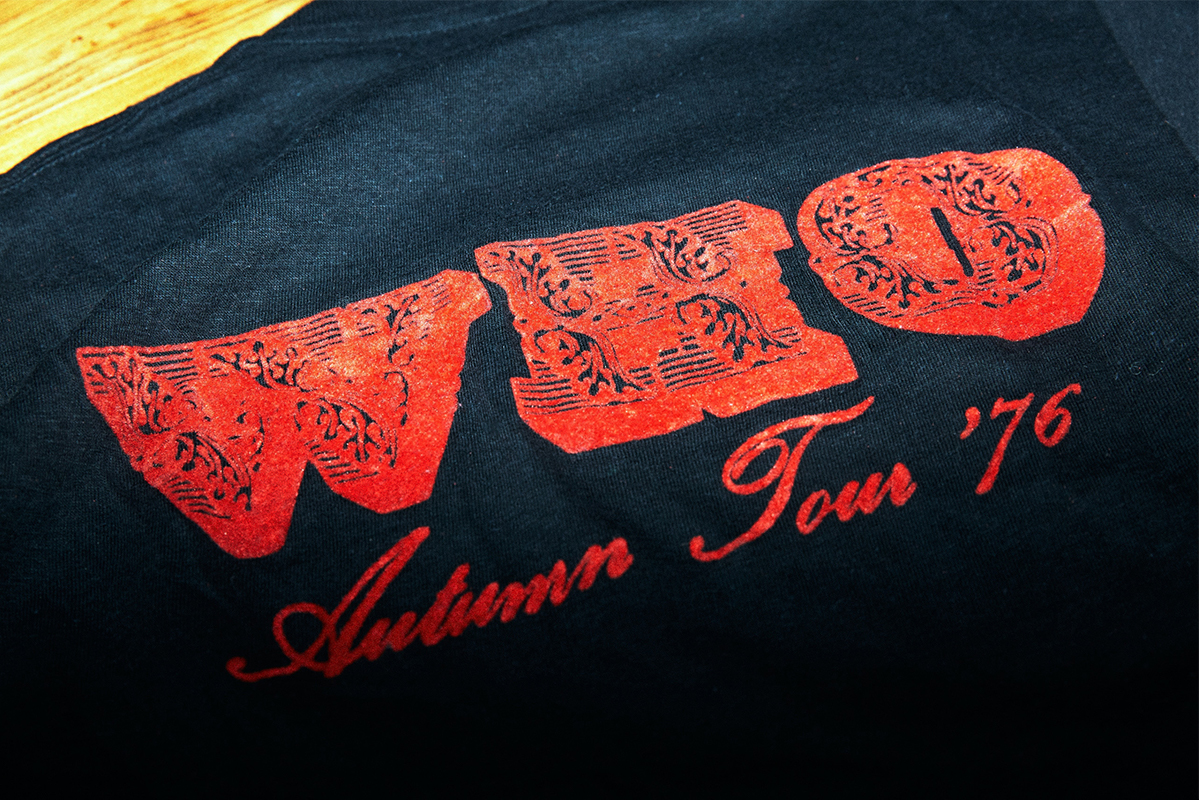
--- These days these items are considered as a kind of fashion of their own; do you have any idea when this trend actually started?
“I think that must’ve been from the nineties. One of the important players at the time was Nirvana’s Kurt Cobain. He would always be wearing T-shirts made for bands his friends played in, like Sonic Youth and Mudhoney. A lot of fans that also looked up to him as an influencer in the fashion field started wearing similar shirts in their daily life, which lead to it slowly being more and more accepted as a style of fashion. Another big factor was also the people doing their thing in Ura-Harajuku in the nineties.”
--- Now that you mention it, I do feel it’s from the nineties that you notice creators in the fashion magazines wearing band T-shirts.
“Back then, the prices weren’t as high as they are these days, you know? This was still the time that you could buy a really pricey vintage item for under 10.000 yen.”

--- So when did the prices start going up?
“The nineties were also the start of the second-hand clothing boom in Japan. I think the movement itself started with denim jeans, but a while later vintage T-shirts also started gathering attention. That would place it around the zeroes.”
--- Was Japan the first place where people started to put more value on these items?
“I think that like a lot of other vintage items, the fact that band T-shirts started being valued for more than their original price and were resold was originally a Japanese thing. From around the zeroes, there were more and more people who would go to Japan from abroad, mostly America, to buy these items, and those people would reimport them to their own country and sell them there. Of course, this meant that the prices jumped up quite a bit. This series of events lead to the end result that vintage band T-shirts, like other items, gained a lot of added value on a world scale.”
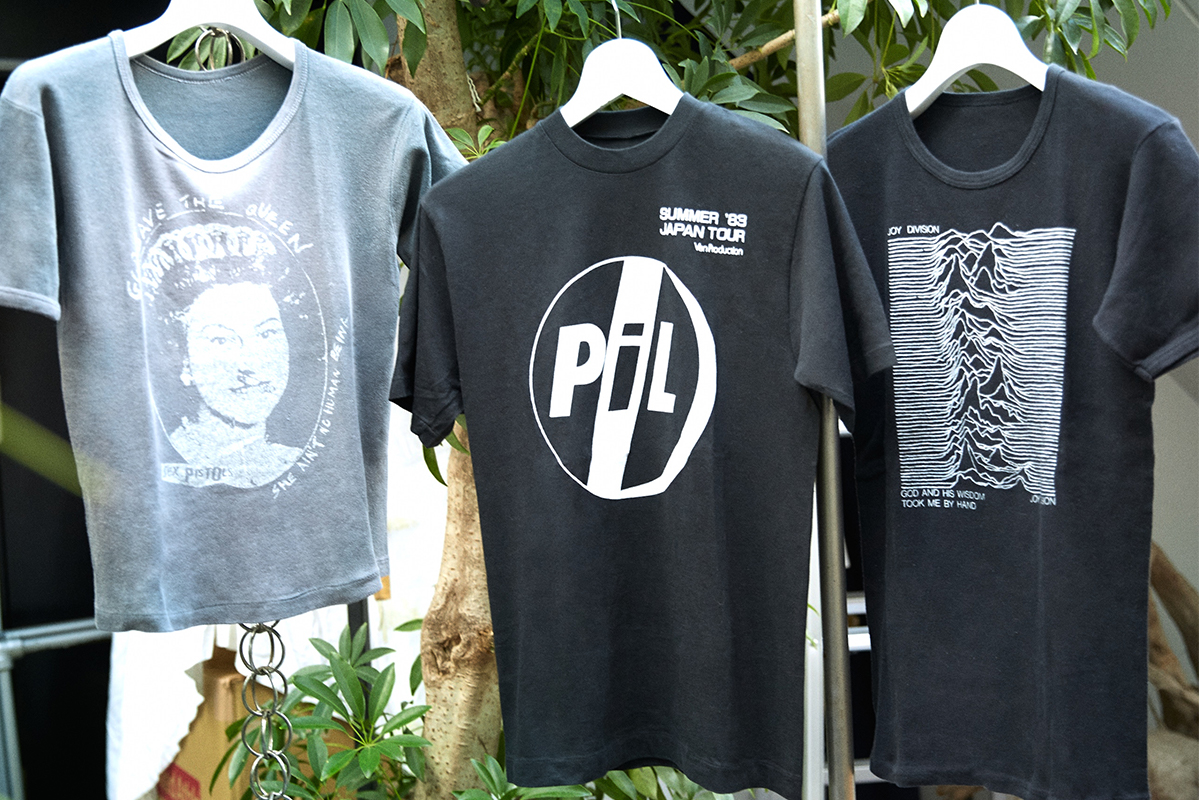
--- Some of these items have also been used a lot as a source to sample for new items by all kinds of brands by now. When do you think this trend started?
“Some of the more hardcore brands already started with that in the nineties, but the more world-famous brands only really started after around the year 2000. An important player there was fashion designer Hedi Slimane, who was one of the first designers to combine rock and fashion in his designs. One of his more famous designs in that aspect are his Madness T-shirts.”
--- It seems like that aspect in itself means that band T-shirts had become more intertwined with fashion by this time. Can you think of any brand T-shirts in this genre that have left a lasting impression?
“I think the most impressive here is Raf Simons. I loved the designs where he used the album artwork of bands like Joy Divisions and New Order for his items. You can really feel the love he had for not just the music, but also for the original artwork, designed by Peter Saville.”
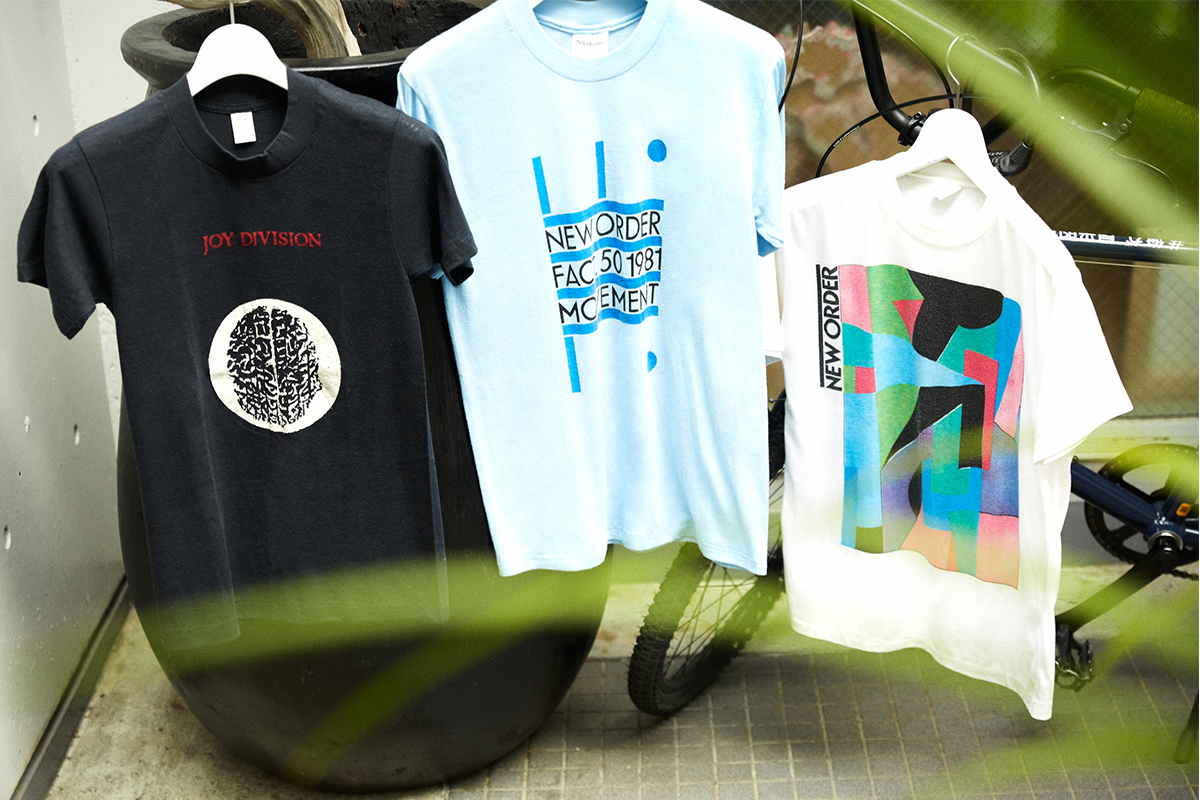
--- I see! Peter Saville’s designs have a lot of passionate fans after all.
“Band T-shirts are a way of expressing your love for a specific kind of music, as well as being fashion, and art at the same time. These three are kind of intermingled to form one genre. One of the best examples for this are the designs by Andy Warhol. He was an artist himself, but also did some producing work for The Velvet Underground and Nico. That band recently did a collaboration with Supreme as well. If you consider it from that aspect, you realize everything’s really connected.”
--- Using band T-shirts as a source to sample also feels like one of the characteristics of street brands.
“The first association I have there is of course Supreme. I don’t think there’s any other brand that featured so many designs of bands from such an early stage other than them. And they have an eye for good music as well: Black Sabbath, Bad Brains, John Coltrane. When they started out in 1994, a lot of these items were still unofficial, but before you know it they’ve made their way into the official channels as well. That’s of course amazing as well. A recent favourite are the T-shirts made for The Smiths.

--- Do you have any other favourites that have been sampled in an interesting way?
“I also really love this T-shirt of Peko-chan, the mascot character for the Fujiya Corporation (a chain of confectionary stores in Japan) that Supreme did as well. Unfortunately, because it’s unofficial and the company itself said no to the idea, it was never officially sold in Japan. But the interesting thing is that the original idea for this design wasn’t this T-shirt; it was actually based on a T-shirt sold as merchandise for the band Redd Kross. That’s the kind of trivia that makes this genre of fashion really interesting as well.
--- You also brought us a T-shirt from the Metallica collection; could you tell us why?
“I brought it with me today because it has been gaining popularity over the last few years. Some brands that are somewhere between street and high fashion, using the Metallica logo boldly as a design. For example, I was really impressed by the T-shirts from Balenciaga and Vetements. They were definitely influenced in designing these by Demna Gvasalia (A former designer for Vetements and the artistic director for Balenciaga). I get the feeling he personally is a big fan of Metallica.”
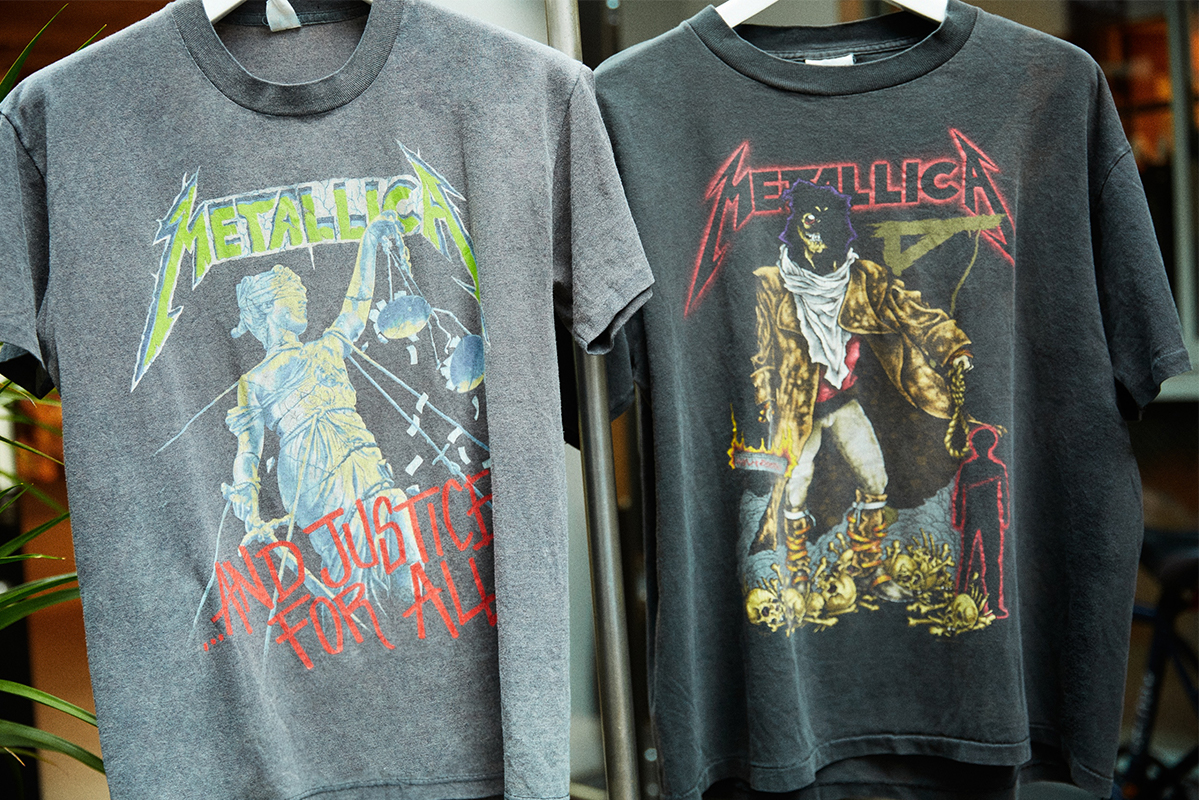

--- Do you have any T-shirts for us that fit well with today’s theme?
“I have this one T-shirt with that’s not actually a band T-shirt. This one was made by Steven Sprouse, an artist active in the nineties.”

--- Is there any reason you decided to bring a T-shirt that’s not actually band merchandise?
“Stephen did some works based on artists like Iggy Pop and The Doors’ Jim Morrison, and also designed some stage outfits and album covers; he was very much involved with the music industry. What made him world-famous was his collaborations with Louis Vuitton. His designs were featured in the 2001 S/S collection designed by Marc Jacobs, called Monogram Graffiti. It’s no surprise as everyone knew Marc was a big fan of Stephen’s work, but his work also inspired many other artists and musicians. At the heart of Stephen’s creativity was everything; music, fashion and art, which is why I think the T-shirts he worked on were some of the ultimate rock T-shirts.”
--- What kind of band T-shirts do you think will get their day in the limelight in the future?
“In the past, punk people would wear punk T-shirts, Hip Hop people would go for Hip Hop, that was the normal trend, right? But these days, it’s completely normal to see a rapper like ASAP Rocky wearing a band T-shirt too. Considering the situation from that context, honestly, I have no idea how things will develop. I for one am really looking forward to a future just because I have no way of telling what might happen. But I think the value that band T-shirts have will definitely stay the same, and I think that bands from after the zeroes will also start gathering attention as a new genre of band T-shirts in the future.”
--- I get what you mean. The previous period will always become the new vintage, as is the way it has always gone.
“Another thing I think will happen is that because of new developments in technology, many high-quality rip-offs will also start to make their way into the circuit. That’s why the existence of professionals who can recognize what is real and what is not and get rid of the fake items will become very important as well.”

--- Are there many fake items out there already?
“Yes, probably more than you can imagine. But as far as band T-shirts go, it’s not like bootleg items are worthless either. The bootleg items I’m talking about, for example, were specifically made to resemble vintage T-shirts from the eighties and are really close to the original; they’re being sold as ‘the real eighties thing’ which is frankly a very sad story.”
--- I don’t even need to put this into words, but the amount of vintage band T-shirts will grow smaller and smaller as time goes on. Of course, that makes the real thing worth only more and more.
“That’s true. When looking at people like Warhol, you realize that band T-shirts are conceptually really close to art pieces. That’s why they grow in value in the same way art does. And if someone uses an artwork to design a product, the value can go through the roof as well. Band T-shirts will probably continue to slowly make their way from music to fashion, and all the way into modern art.”
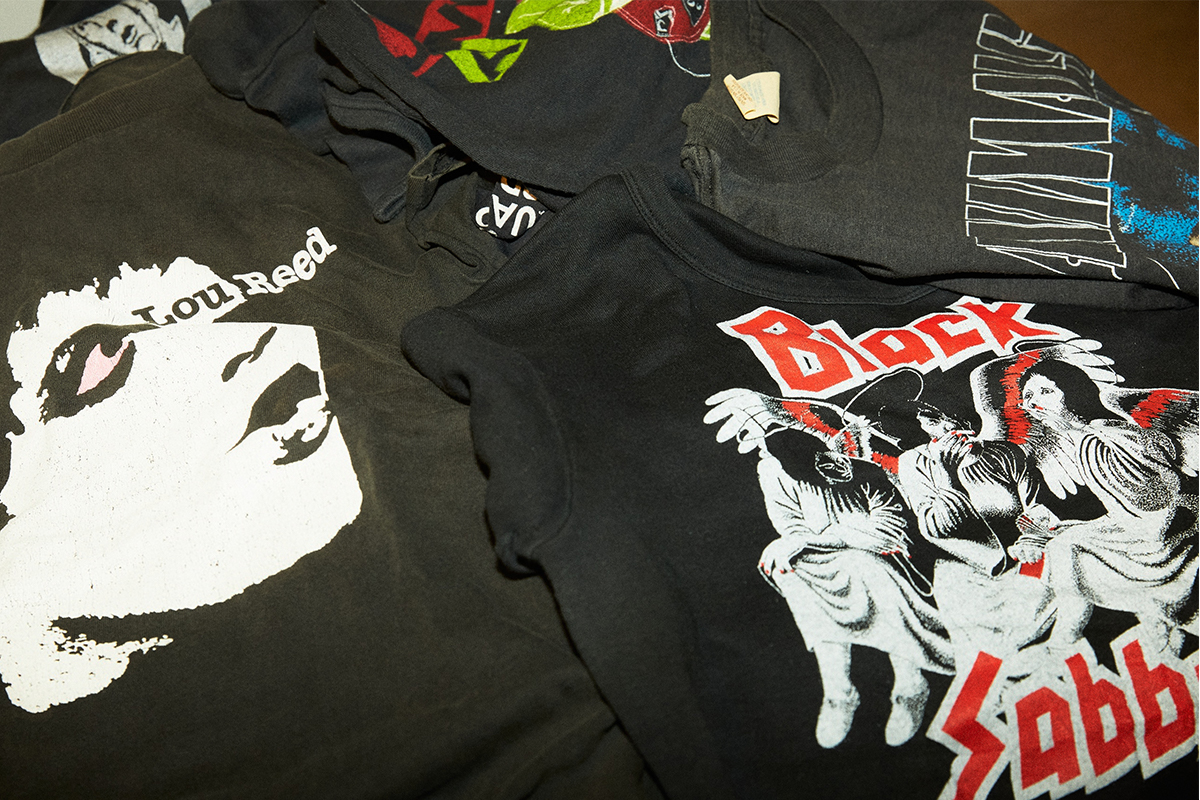
RYOHEI MATOBA
offshore Managing Director/LABORATORY/BERBERJIN® General Manager
LABORATORY/BERBERJIN has a collection of vintage T-shirts that is one of the largest in the world, and Mr. Matoba is its general manager. As a side project, they started a select shop called offshore in 2017.
Photo_ Ryo Kuzuma
Text_ Hisanori Kato
